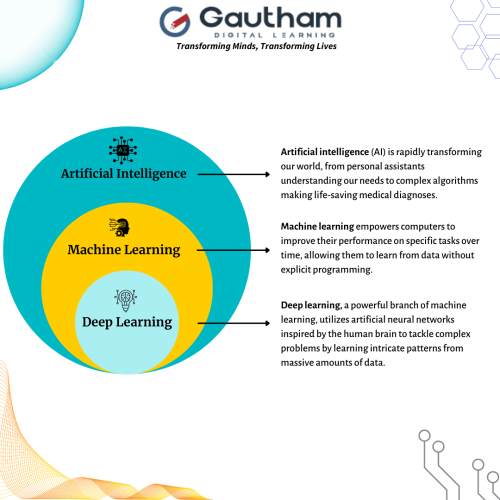Prompt Engineering
Welcome to the world of prompt engineering! This course will equip you with the knowledge and techniques to communicate with large language models, like me effectively. By learning how to craft compelling prompts, you’ll unlock the potential of AI to perform various tasks, from creative writing to data analysis. Get ready to master talking to AI and unleash its potential!
Why Prompt Engineering?

What is Prompt Engineering?
Prompt engineering involves crafting precise and effective inputs (prompts) to guide AI models in generating accurate and relevant responses. This skill is crucial for optimizing the performance of AI in various applications, from content creation and customer support to educational tools and creative writing.
Prompt engineering is akin to programming with natural language. Unlike traditional programming, which uses code to instruct computers, prompt engineering uses human language to interact with AI models. The prompts are designed to exploit the pre-trained capabilities of models like GPT-4, leveraging their vast knowledge and understanding of language to perform specific tasks.
Prompt engineering is more than just writing lines of code; it’s about shaping conversations, generating creative content, and solving real-world problems. Imagine having the ability to create Chabot’s, generate poetry, or even compose music—all through the magic of well-crafted prompts.
Course Curriculum
- Transformative Impact of AI: Examine how AI technologies are revolutionizing industries such as healthcare, finance, and beyond, fundamentally altering how we work and live.
- Introduction to Prompt Engineering: Understand the role of prompt engineering in enhancing AI applications across sectors.
- Historical Evolution of AI Models: Trace the development of AI from simple algorithms to complex Large Language Models, emphasizing their growing impact in various fields.
- AI and Machine Learning Basics: Explore foundational concepts and their impact on automation and predictive analysis.
- Deep Learning and Neural Networks: Dive into neural networks and how they mimic human brain processes to solve complex problems.
- Natural Language Processing (NLP): Learn key NLP techniques for processing and analyzing human language.
- Essentials of Prompt Engineering: Learn why prompt engineering is crucial for guiding AI models to achieve specific outcomes.
- Types and Uses of Prompts: Differentiate between various prompts and their applications. Differentiate between various prompts and their applications.
- Crafting Effective Prompts: Master the art of creating prompts for precise AI responses.
- Survey of AI Models and Tools: Overview of tools like GPT for text generation, DALL·E for image creation, and Codex for coding.
- Hands-On AI Tool Applications: Practical exercises on using these tools for content creation and software development.
- ChatGPT (OpenAI): Advanced language model for generating human-like text.
- MIDjourney: AI-driven design and creative processes.
- HUMATA: Enhances human-machine interaction.
- Feedly: AI-powered news aggregator.
- Gemini: AI-enhanced security solutions.
- Bard (Google): Conversational AI for diverse tasks.
- Heygen: Predictive insights for business decisions.
- Zapier: Workflow automation with AI.
- Scribe: Auto-generation of step-by-step guides.
- Wordtune: AI writing assistant for clarity and style.
- Buffer.com: Social media management with AI.
- Descript.com: AI-powered audio and video editing.
- WebChatGPT: Integrating GPT models into web applications.
- Monica: AI-driven personal CRM.
- PromptPerfect: Creating effective prompts for AI.
- DALL-E 2 (OpenAI): Generating images from text.
- Luma-AI: AI tools for filmmakers.
- Wonderstudio: Automated professional-grade videos.
- DreamStudio.ai: High-quality digital art creation.
- Advanced Prompting Techniques: Develop skills for crafting complex prompts that refine AI outputs.
- Troubleshooting Prompts: Address common challenges in prompt response optimization.
- Real-World Applications: Analyse prompt engineering case studies across different domains.
Contact us:
+91 90145 29858




Benefits of Learning Prompt Engineering
Prompt engineering isn’t just about giving orders to AI. It’s about having a conversation, one that unlocks the true potential of large language models (LLMs). By learning this valuable skill, you’ll gain a toolbox of techniques to:
- Stay Ahead of the Curve: Prompt engineering is a game-changer. By mastering this skill, you’ll position yourself as a valuable asset in the age of AI and navigate the technological frontier with confidence.
- Boost Efficiency: Automate repetitive tasks and streamline workflows with effective prompts. Free up your team’s time and resources for higher-level thinking.
- Spark Creativity: Hit a creative wall? Prompt engineering can be your muse. Generate fresh content ideas, explore new design possibilities, and break through creative roadblocks.
- Get More Accurate Results: Tired of wading through irrelevant AI outputs? Craft prompts that guide LLMs towards exactly what you need, saving you time and frustration.
- Make Better Decisions: Turn AI analysis into actionable insights. With precise prompts, you can leverage AI to uncover hidden patterns in data and make data-driven choices with greater confidence.
- Personalize the Experience: Imagine tailoring content or recommendations to individual users. Prompt engineering allows you to create targeted experiences that resonate deeply with your audience.
Applications of Prompt Engineering
Prompt engineering plays a crucial role in enhancing interactions between humans and machines. Let’s examine how it can be used in different areas:
- Content Generation:
- High-Quality Copywriting: Use prompt engineering to generate engaging blog posts, articles, and marketing materials that align with your brand voice.
- Creative Writing: Enhance creativity in story writing, script development, and other creative content by fine-tuning AI prompts.
2. Generating Code:
- Prompt engineering enables efficient code generation and problem-solving.
- Imagine having an AI assistant that assists with code snippets and debugging!
3. Summarization:
- Accelerating document summarization processes.
- Users can distil key insights efficiently and manage complex tasks seamlessly.
- Useful for summarizing research papers, news articles, or lengthy documents.
4. Contextual Question and Answer:
- This guides language models in generating accurate and informative responses to user queries.
- Think of it as creating well-structured questions for better answers.
5. Data Analysis and Reporting:
- Automate the generation of comprehensive reports by guiding AI to analyze data and present findings effectively.
- Leverage AI for predictive modeling by designing prompts that help forecast trends and business outcomes.
6. Customer Support Automation
- Develop prompts that guide AI to understand and address customer queries swiftly and accurately.
- 24/7 Support: Ensure your AI-driven support system is always available, providing consistent and reliable assistance to customers around the clock.
7. Educational Tools
- Personalized Learning: Create customized educational content and tutoring programs tailored to individual learning styles and needs.
- Interactive Simulations: Develop engaging and interactive simulations for various educational purposes using AI-generated scenarios.
Best Practices for Writing Prompts
Writing effective prompts is crucial for eliciting the best possible responses from AI systems. Here are some best practices for crafting good prompts:
- Provide Context: Give the AI enough background information to understand the scenario and respond appropriately.
- Be Specific: Clearly state what you want in the response. The more detailed your prompt, the more accurate the AI’s output will be.
- Build on the Conversation: Treat the interaction as a dialogue where each prompt builds on the last, refining the direction and focus of the conversation.
- Use Simple Language: Avoid technical jargon unless necessary and keep the language straightforward to prevent misunderstandings.
- Conversational Tone: Engage with the AI as you would with a human, using a natural and conversational tone to make the prompts more intuitive.
- Actionable Requests: Make your prompts direct and actionable, so the AI knows exactly what to do.
- Relevance: Ensure that your prompts are relevant to the task at hand and the user’s needs.
- Open-Ended Questions: When appropriate, use open-ended questions to encourage various responses and stimulate creativity.
- Sensory Language: Use specific details and sensory language to make the prompt more vivid and engaging.
- Tailor to Audience: Consider the intended audience and objectives of the writing to make the prompts more effective.
Remember, the key is to communicate with the AI in a way that guides it towards the desired outcome while being clear and concise.
Frequently Asked Questions
Prompt Engineering is the art of crafting effective instructions for large language models, such as ChatGPT. It involves creating prompts that tap into the powerful capabilities within these models.
To excel in prompt engineering, you'll need a solid understanding of natural language processing (NLP) concepts, familiarity with large language models, and the ability to create well-structured prompt.
- The Prompt Engineering specialization covers various topics, including:
- Understanding large language models
- Crafting effective prompts
- Applying prompt engineering techniques to automate tasks and augment human intelligence.
Proficiency in prompt engineering can open up opportunities in fields such as:
- Natural language processing (NLP)
- Data science
- AI research and development
- Content generation
- Automation.
Crafting prompts that yield desired responses from language models involves a mix of art and science. Here are some tips:
- Be specific
- Use context
- Experiment
- Length matters
- Avoid ambiguity
- Fine-tune if needed
No, you don’t need to install any additional software.
Many prompt engineering courses are available online, offering flexibility for learners to study from anywhere at their convenience. Online courses often include video lectures, interactive sessions, and forums for discussion.
Prompt engineering can be applied in various domains such as customer service (chatbots), content generation, data analysis, automated reporting, virtual assistants, and more. It enhances the functionality and efficiency of AI-driven applications.
By learning prompt engineering, you can improve content creation, automate tasks, personalize user experiences, and gain a competitive edge in fields like marketing, customer service, and research.
The course duariation is 30 working days.
To enroll our course call us at +919014529858.
Our Courses
A full-stack Python developer utilizes both the front-end and back-end components of web applications.
A Java full stack developer crafts both the interactive elements and the data processing engine of a web application using Java.
ServiceNow training equips you with the skills to manage IT service requests, incidents, and changes using the ServiceNow platform.
AWS DevOps integrates various aspects of software development and operations, aiming to shorten development life cycle.
Linux administration training teaches you how to install, configure, and maintain Linux operating system.
Salesforce training empowers you with the skills needed to become proficient in the world's leading CRM system.
Mulesoft provides software that connects applications, data, and devices that automate tasks and integrate various systems.
Digital marketing uses search engines and social media channels to connect with customers and promote products or services.














